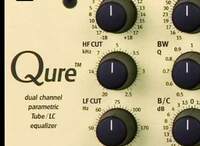
Review by George Shilling
Whilst Crane Song lovingly craft transistor-based birds, Thermionic have been building an increasing reputation for bird-based quality valve gear over the last few years. I have long been a fan of their big-sounding Phoenix compressor, and their latest models have evolved into solidly-built, high-class boutique products, with their feet firmly in the valve past.
The legending and finish on these two units exhibit a few idiosyncrasies, with panel layouts that require a couple of minutes’ consideration to fully absorb. Instead of Boost EQ In you are presented with ‘Active Lift’. Legending is a messy mixture of block caps, italic caps and lower case. And some of the it is slightly obscured by toggle switch surrounds. Flipping the Power toggle On illuminates a ludicrously blinding green lamp. But all this is absolutely part of the unique and slightly eccentric charm!
The Earlybird is a dual channel mic/line preamp, with separate Line, Mic and Pullet inputs, with three-band boost EQ on each channel. Valves are run at 330 Volts on the input and 250V on the output.

The Pullet is a companion unit, described as a ‘Mini Passive Equaliser’. This provides additional mid and high EQ in a stereo unit. However, being completely passive, The Pullet requires a preamp with +40dB gain on its output to bring the level back to normal. Any microphone preamp can be used, but the Earlybird features a separate pair of Pullet inputs for the purpose, and impedances are factory set (but adjustable) in the Pullet so that its Bypass results in unity gain when the units are paired. However, with the extra post-Pullet gain requirement, for two full mic preamp and EQ channels, you will need a Pullet and two Earlybirds!
The Earlybird’s lethargic non-standard VUs sensibly feature a compressor in their path so as to damp the indication at normal (digital) levels. There are two indicated impedance settings for the mic inputs. At 1200 ohms, a large condenser sounds clear and open, but at 300 ohms it sounds more gluey, but in a nice, warm, vintage radiogram manner. The same goes for a cheaper dynamic mic. Despite the choice of impedances I felt the Earlybird slightly underperformed with the budget ribbon mic I had to hand. It sounded absolutely fine, but not noticeably improved than when the mic was paired with a 1073 clone, whereas other mics sounded clearly better with the Thermionic, with more depth and immediacy. The third position marked Pad lowers level by 18dB and increases impedance to around 20 kilohms, for a clear, open sound similar to the 1200 ohm position.
The Bass Cut section features varyingly shaped filters at four different frequencies. The lowest setting at 40Hz is quite dramatic – you might even hear its effect (just) on the NS-10s. Higher frequency settings are increasingly gentle. The ‘Active Lift’ section is a three-band boost only EQ. Boost amounts are, strangely enough, extremely dependent on the particular Gain setting of the preamp, as they work in the negative feedback loop – as mic Gain is increased they become less effective, (as feedback is reduced to increase main Gain!) The Top boost is a shelf lift above 7kHz, but at full boost there is a peak at 10kHz. Large increases can emphasize harshness, but smaller amounts add sparkle. The Mid boost is a broad curve selectable at 0.8kHz or 2.5kHz, the former great for enhancing vocals, the latter adding grit. The Bass section boosts as a broad 60Hz or 100Hz shelf, for a great warm bottom end. This is the kind of broad EQ where overall gain always increases, and turning everything up sounds good!

The add-on Pullet unit is a dual EQ, with XLR inputs and outputs on the rear, but no mains power input – the unit is entirely passive. As such, it requires approximately 40dB of gain on the outputs to bring the level back up to normal line level. When using the Earlybird at line level rather than as a mic preamp, one can utilise the Earlybird’s preamplifiers, but if a mic preamp is required, chaining the Pullet back into the second channel is a possibility. There are dedicated Pullet inputs on the rear of the Earlybird, selected from the front panel. These seem to operate exactly as the microphone inputs, (but without the provision of 48V phantom power).
The Pullet provides Mid Lift of up to 21dB, with 11 switchable frequencies and three different Q settings. In typically eccentric fashion, the Q toggle for the mid band is Hi at the top position, Lo and the mid position, and Med at the bottom! The Mid Cut settings have a broader set of frequencies, allowing low-mid cuts, at a fixed, fairly narrow Q. The High Top section provides a fixed 6dB Cut at 6kHz, 11kHz or 15kHz, or Lift at 10kHz, 12kHz or 15kHz. Bypass toggles leave the transformer in circuit for level matching. The Pullet makes a great partner for the Earlybird, especially for mix or track insertion. It is difficult to seriously harm the signal with EQ like this.

Although narrow Qs are available, this isn’t what you would call surgical, but more akin to the gentle shaping of a Pultec, yet perhaps even broader - more powerful, honest and straightforward. On both the Pullet and the Active Lift sections, the Cut and Boost knobs simply range from 1 (no effect) to 11, with no particular scaling – this is a suck-it-and-see device, where ears are required! It is thoroughly satisfying to use, and works a treat on mixes and individual or stereo signals, with lovely juicy enhancement.
Designer Vic Keary is without question the finest practitioner of valve audio design, and these lovingly hand-built units are highly desirable to the keen-eared. Birds, eh? Can’t live without ‘em!
Pros
Expertly designed valve and passive gear with thorough regard for design heritage; All the knobs go to 11
Cons
No Instrument inputs; No +48V indicator light; You need another dual preamp for both mic amps and Pullet simultaneously
Back to the equipment reviews
Reproduced with kind permission from George Shilling. Copyright George Shilling.





